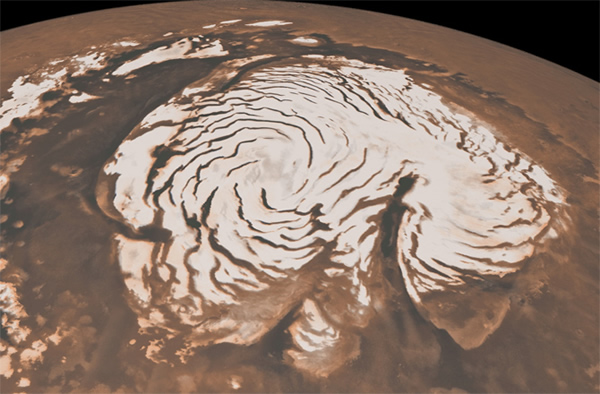Will Mars Have a White Christmas?
Mars' thick northern ice cap is about the size of Texas.
There will be a white Christmas on Mars, say scientists studying how much of the Martian polar caps are created by winter snow falling from the rusty sky.
“Yeah, it will be a white Christmas on the south pole of Mars,” said Paul Hayne of NASA's Jet Propulsion Laboratory and coauthor of a paper about Martian snowfall in the journal Icarus.
But the similarity to Earthly winter ends there. With a very dry atmosphere that's 95 percent carbon dioxide, it's that gas which freezes in the sunless polar air to form clouds that allows snow to fall.
"When the temperature drops below the CO2 condensation level (-128 C or -199 F in the thin Martian air), mainly in the winter polar regions, the CO2 condenses to form ice," explains Tohoku University's Takeshi Kuroda and colleagues in an earlier study this year of Mars' polar clouds. "This process significantly changes the total mass of the Martian atmosphere. Measurements from Viking landers showed annual variations of 25 percent in the surface pressure, with the maximum pressure being observed around the northern winter solstices, and the minimum in the northern summers."
On Earth this would be the equivalent of our atmosphere's dominant gas, nitrogen, freezing out of the air and falling to the ground (except, Hayne points out, that on Earth the heavy atmospheric pressure would cause nitrogen to first rain out as a liquid, whereas in the thin air of Mars carbon dioxide skips from gas to solid).
“That's the cool thing about this,” said Hayne. “It has no analogue on Earth. (On Mars) the air around you is getting thinner.” The only other places in the solar system where the atmosphere seasonally freezes to the ground is perhaps Neptune's moon Triton and Pluto.
To estimate of how much of the wintertime dry ice at the Martian poles is deposited by snowfall, Hayne and his colleagues approached the question in two ways using polar cloud data from the Mars Climate Sounder instrument on the Mars Reconnaissance Orbiter. First they used the thickness of the clouds -- judged by how un-transparent, or opaque, they were -- to calculate how many ice particles were in the air.
“Once you have that number you can calculate how fast clouds would fall to the surface,” Hayne said. “When we did that it was around 10 percent."
Their second method was to take the cooling rate of atmosphere in the sunless polar air, using thermal emissions collected by the Mars Climate Sounder and convert that into a rate of snow forming in the clouds. This works because when the gas changes into a solid, some heat is released, which causes a measurable bump in the cooling of the air. This approach gave them the same number: about 10 percent of the seasonal ice was from snowfall. Their overall estimate is that snowfall contributes between 3 and 20 percent of the polar ice caps in winter.
“As far as I know nobody has seen CO2 particles on the surface,” said Hayne. And it's not likely to be seen close up any time soon. The reason is that the conditions when this happens are dark and extremely cold. They would kill all but a nuclear-powered lander or rover.
If a probe does ever get to that region and survive the winter, it will see no fluffy flakes fluttering down, Hayne said. Labotatory experiments have revealed that carbon dioxide snow would be rather anticlimatic. Crystals of CO2 snow would be no bigger than 1/10th of a millimeter in any dimension -- basically dry ice dust.(Dec 23, 2013 03:01 PM ET // by Larry O'Hanlon)












